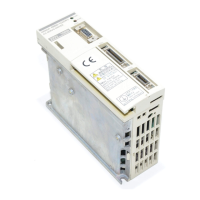1-6
D Speed Loop Proportional Gain
• The response characteristics of the Servo System in all frequency bands change by adjusting this
gain.
• The compensating force and response characteristics rise if the gain increases.
• Increase the gain as much as possible provided that the adjusted gain does not cause machinery
vibration.
D Speed Loop Integral Gain
• The response characteristics of the Servo System in low frequencies change by adjusting this gain.
• The servo-lock force rises if the gain increases.
• Increase the gain as much as possible provided that the adjusted gain does not cause machine vibra-
tion.
In the case of the U Series, decrease the value of the speed loop integral time constant.
D Current Command Filter
• The response characteristics of the Servo System in high frequencies change by adjusting this gain.
• If the value of the filter time constant is large, command changes will be made less extreme and will
then be provided to the current loop.
• The adjustment of the current comment filter will be effective if machinery vibration does not stop with
the adjustment of the speed loop proportional gain and integral gain.
Adjustment Example 1
• Refer to the following for the normal adjustment of the Servo System that will not require any adjust-
ment of the current command filter to stop machine vibration (i.e., the current command filter is used
with factory settings).
• Adjust the proportional gain first, and then the integral gain.
Before Adjustment
Machine resonance point
Frequency (operating speed)
After adjustment
Increase the integral gain pro-
vided that the adjusted gain does
not cause machine vibration.
Increase the proportional gain
provided that the adjusted gain
does not cause machine vibration.
Frequency (operating speed)
Compensating force
Compensating force
Gain Adjustment Chapter 1

